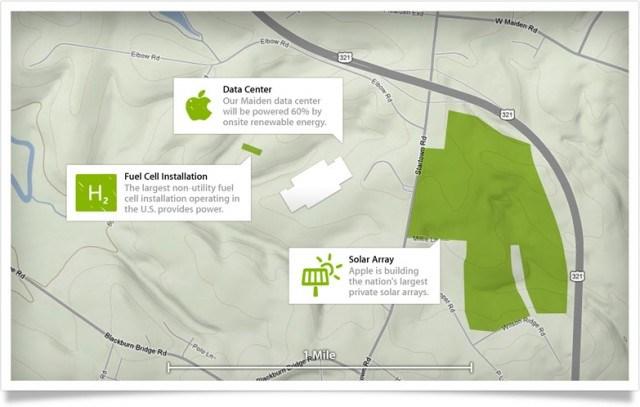Data Center Renewables Starting to Have a Ripple Effect


Last year, in its ongoing campaign to get Amazon to commit to renewable energy, Greenpeace gave out mugs one Tuesday at lunchtime outside the company's headquarters in Seattle. The cups said “Amazon Web service is green” until staffers got back inside and filled them with coffee, at which point the heat changed the message to: "Why isn’t Amazon Web service green yet? Google is.” It wasn’t just mugs.
But Greenpeace’s campaign to get Amazon to go renewable for its massive data center operation won out last month, with a quiet announcement posted online that Amazon has “a long-term commitment to achieve 100 percent renewable energy usage for our global infrastructure footprint.” That footprint includes the multibillion-dollar cloud that is Amazon Web Services, which hosts the files for Netflix, Pinterest, AirBnB and many other massive companies.
Greenpeace’s renewable data center campaign has been remarkably successful, especially when you look at the size of these companies and the amount of energy the data centers consume. The organization estimates that the cloud consumes as much electricity as a country – and in fact, it would be the sixth-largest country in the world, according to two Greenpeace reports rating 20 companies on their fossil fuel use. Just the companies they surveyed accounted for 300 data centers.
It only took Apple only two years to go from “dirty” to 100 percent renewable energy at all of its facilities. A lot of the other companies that did decide to commit to clean energy, like Google, Yahoo, Facebook, eBay, Rackspace, Box, Salesforce, Microsoft and others, also made strides in very short times. Part of this was really the culture of the tech industry. “Employees have been some of our strongest allies,” says David Pomerantz, the energy campaigner working on Greenpeace’s data center program (hence the coffee mugs). Scientists and engineers really felt passionate about climate change, he said.
But what’s even cooler is that these tech companies have had a ripple effect in the states where they've gone shopping for clean energy. In Utah, Iowa, North Carolina and Oregon, state energy policies and utility agreements have been changed in order to accommodate these companies coming to town and building data centers, which provide highly desirable jobs. These changes – which have made it easier for other companies to purchase clean energy – came as a part of the process.
“How difficult it is to buy renewables varies in different states,” said Pomerantz. When Greenpeace was working with tech companies interested in this, companies simply couldn’t call a utility and ask to buy 100 percent renewable power for their new centers. Energy companies didn't offer it, and some states have energy monopolies. In states like North Carolina, where Apple and Google recently built new data centers, it was illegal to buy power from anyone but the public utility.
North Carolina is an interesting example: of progress, but also how embedded fossil fuels are in the system. Google, Facebook and Apple are negotiating to get North Carolina's Duke Energy to sell them renewable power packages. But Duke only agreed that this would be offered to new demand, post 2012.
When the University of North Carolina later approached Duke to sign a similar agreement to meet the college’s sustainability goals, Duke refused, saying that the renewable options would only apply to new contracts.
“Duke is being dragged into this by its customers. It did not exactly encourage broad uptake,” said Pomerantz. Some of the other tech companies found resistance as well.
In other locations, however, the tech companies' renewable investments are projected to lower prices for all consumers. (Some of these best practices stories can be found starting on page 29 of the Greenpeace report, Clicking Clean: How Companies are Creating the Clean Internet.)
In Iowa, the combined entrances of Google, Facebook and Microsoft got MidAmerican Energy to invest $1.9 billion in wind power, including the world’s largest order of onshore wind turbines.
MidAmerican CEO Bill Fehrman said in an October statement that “with this proposed expansion, beginning in 2016, MidAmerican Energy’s wind resources are expected to produce an amount of energy equivalent to approximately 50 percent of the retail energy customers are expected to need,”
“We’re extremely proud of how far we’ve come as a state, and as a company, since the installation of our first wind turbines a decade ago. These wind projects help stabilize rates in the long term for our customers, foster economic development in Iowa communities, and demonstrate MidAmerican Energy’s commitment to the environment,” he continued.
Read more about the Green Internet campaign, including the companies' commitments and progress, here.
Image courtesy of Greenpeace
Wear What You Stand For: Uniting Humanity Through Fashion


Editor's Note: This post originally appeared on Little Pickle Press.
By Shamini Dhana
There are many universal mediums today that allow us to cross boundaries in shorter periods of time and without censorship. We’re talking about Twitter, Facebook, Google and the networks of the future. But have you thought about the non-virtual world as an instrument of change? It has the ability to transform our consciousness, providing knowledge of the world through the wisdom of cultures. Welcome to the world of fashion and the daily ritual of wearing a piece of apparel every day that has the potential to “define” you.
We’re familiar with the stories and research that indicate that an unconscious judgment call is made, a perception created at some level, within the first 40 seconds of physically meeting someone new. Interestingly, what you wear plays as an important part in the casting of that vote, as does the way you wear your hair or makeup, your voice and your posture. Such is the power of fashion — the ability to define one from the outside.
Now we look at the power of fashion to define and transform the individual from the inside, too. Ponder for a moment the ability to connect with people and planet through our clothes -- what would you say to this? In reality, this concept is absent in our daily conversation because brands and companies that produce, market and sell clothing today have kept this information from us; they have denied it as a priority and denounced the impact that this information can have on the overall shopping and purchasing decision we as consumers make on a daily basis.
The reality is that our clothes are just as important to our overall well-being as the food we eat. If food fuels the body, provides energy and ability to perform our work, and is a medium to celebrate seasons and festivities, then the clothes we wear have the same ability to transform ourselves both inside and out. In fact, I would say that if we are what we eat, then we wear what we stand for.
We realize that fashion has the ability to define us as edgy, classic, outdoorsy, punk, powerful and bold. But it’s also a way to also transform our psyches, shape our values and rethink our impact in this world. The brands we wear are more than just color, style and print. At Dhana, Inc., our apparel represents the work, livelihood, inspiration and fate of real people and resources from our planet. Each person along the journey has a story to share — from where and how people live to how they have been treated, compensated and acknowledged for the work they do. Clothing has a story of fabric and fiber that no fortune can possibly replace — one that speaks to the heart and soul of why we do what we do. These are the stories worth investigating, discovering and sharing.
We learn more about ourselves when we connect with the world — not just virtually, but through all of the elements that lend themselves to honoring the people who make our daily lives joyful and fun. We have the ability to be more conscious in our choices. We also have the power to vote with our dollars, supporting the decisions of companies and brands that share vital information that impacts our well-being and that of the planet. It is this triple bottom line (people, planet and profit) that reflects this type of business practice and is what is expected of the conscious consumer for the good of the world.
Every day we wear a piece of clothing that has touched several people along the way. It is something most of us take for granted. Perhaps it’s time to revisit this journey, to step back and ponder how aligned each piece of clothing is to our own values. Let’s celebrate the fact that fashion has the potential to connect us in deeper and more profound ways.
Dhana is a mission-driven company and offers a solution to connect people and planet through our clothes. We strive to unite the beauty of nature, the choice of natural, organic elements, the celebration of world cultures, the creative genius of global artists, the passion of entrepreneurs and the voices of children through the universal medium of fashion. TIMELESS FASHION. Together We’re Wearin’ the World!
Image courtesy of Dhana Ecokids
Shamini Dhana is the founder and CEO of Dhana Inc. As an entrepreneur, speaker, and parent, Shamini continues to give back to the global community through educating kids on the impact of their choices every day, and through partnerships with other socially and environmentally conscious organizations.
Where Do Companies Source Their Materiality Data?


By Marion Dupont & Laia Puig
When it comes to materiality, companies are faced with an increasing pool of documents, webinars, blog posts, articles or best practices shared in numerous sustainability or corporate responsibility websites. Most of these highlight the importance of conducting a materiality assessment process including both internal and external stakeholders, while a few others tend to debate over a common definition of materiality that should be common across different reporting frameworks, such as SASB, GRI or IIRC. However, few of them concretely nailed in the different sources a company should look at when conducting its materiality processes, just like the AA1000 Stakeholder Engagement Standard does.
Do all companies conduct interviews on employees? Analyze their reputation on social media? Meet external stakeholders in person? Can we observe differences among different industry sectors?
To answer these questions, we conducted a materiality benchmarking analysis on 50 companies from five different industry sectors: Financial, Energy & Energy Utilities, Food & Beverage, Mining and Telecommunications. We’ve analyzed their reports to identify the different sources they used and the internal and external processes they put in place to conduct their materiality assessments.
Here is the list of key materiality sources we met for most reports, and a great checklist of the different places you might consider looking into to evaluate your own materiality:
We didn’t notice any specific difference among industry sectors, as each company conducted a different materiality assessment than its industry peers, and implemented a process that fit its own corporate culture better. There is no unique materiality assessment process/format/formula which happens to work for all companies; however, we noticed the following trends in our study:
- In terms of process: Some companies started their materiality processes by identifying issues through stakeholder engagement, and then rated them internally in terms of significance. Others identified corporate risks and opportunities internally, and then engaged with stakeholders to rate them. In both cases, the materiality matrix resulting from this process is useful to discover and visualize similarities and disparities between internal business perspectives and external stakeholder concerns.
- In terms of sources: Some of the sources listed above seemed more efficient than others as they appeared more frequently in our panel. “Internal dialogue” was a common materiality source in all sectors, along with “stakeholder surveys” and “interviews” with sustainability or industry experts. Some companies were very creative when it came to “internal dialogue," as numerous ideas were implemented: employee workshops, one-to-one interviews with top or middle management, online portals, and even an Employee Engagement Day.
In conclusion, a combination of qualitative and quantitative research methods and sources will give a balanced view of which issues matter and their relative significance both for the business and stakeholders. Materiality assessment is a requirement for GRI G4, but also is a strategic, management, engagement, reporting and discovery tool -- which should be adapted to both the reality of your company and your stakeholders.
Marion Dupont is the Marketing Manager of Wizness Publisher and helps companies create and publish interactive CSR reports online. She tweets @Wiznessplatform.
Laia Puig is a CSR Consultant of Lavola and works on CSR and sustainability projects, mainly strategies and reporting. She tweets @Lavola_RSE
Amazon Enters the Diaper Business With Promises of Transparency


Amazon has certainly taken plenty of heat over the past several years. The giant online mall has long been criticized for dragging its feet on disclosing its carbon footprint (but never mind, you can of course buy a book about how to reduce your own CO2 impact). Its treatment of workers has also come under scrutiny. Nevertheless the company has tried to tout its “green” credentials, though most observers would only agree its greatest progress has been on frustration-free packaging.
Now the Seattle-based company is promoting Amazon Elements, a line of high-quality “everyday essentials” that supposedly are tested on Amazon employees' families. Curiously, the launch of this Elements line is, for now, limited to disposable diapers and baby wipes. For now these products are only available to Prime customers, but anyone can subscribe to Amazon’s newsletters to see what future offerings are in store.
So, why nappies and wipes? Well, despite the declining birthrate in the U.S., the baby care market is actually growing — it could reach almost $69 billion by 2017. And more of that proportion year after year will be sold online. After all, diapers and wipes are items parents want in plentiful supply — no one wants to be caught with an empty diaper bag or have to make a midnight run for an emergency package. Hence Diapers.com has a steadily growing business — one Amazon would love to, pardon the pun, wipe out.
But Amazon is also going after some of the more “sustainable” baby care products that are currently sold on its site. For example, 40 diapers from Honest Company, one of the more popular eco-friendly diaper brands, retails for just under $30. Contrast that to a box of 200 (about one month’s supply) from Amazon Elements, which are available for about $35.00 — if you subscribe and join “Amazon Mom;” otherwise the price for a one-off purchase is $43.00. If you are a loyal Seventh Generation customer, a supply of 180 diapers that are the first Forest Stewardship Council-certified on the market will set you back about $54 — and they contain no bleach.
Which brand is more sustainable is more a matter of perspective. Amazon emphasizes transparency, so users can track each product’s origins and date of manufacture. Honest Company touts more of its eco-friendly credentials: Instead of tree pulp, absorbency is in part due to a corn- and wheat-based blend in each diaper’s core. Honest Company also uses less sodium polyacrylate, a super absorbent sodium salt that helps keep a baby’s bum dry. Both companies say they avoid latex, perfume and chlorine in their products. Amazon’s description is far more detailed — but claims of caring and transparency will most likely not be enough to sway consumers wary of Amazon’s business practices. Of course, the big question is: What’s next for Amazon Elements? Clearly baby care is only the start as Amazon has its crosshairs on two of its biggest competitors, Walmart and Target. Whether consumers, and workers, truly win in the long run is yet to be seen.
After a year in the Middle East and Latin America, Leon Kaye is based in California again. Follow him on Instagram and Twitter. Other thoughts of his are on his site, greengopost.com.
Image credit: Amazon
Video: John Hardy of Best Buy Talks Diversity at Net Impact '14


As part of our Talking Diversity video series, we spoke to thought leaders at the 2014 Net Impact conference. about what diversity means to them. We received all sorts of responses, from tips on diversity and inclusion management to personal stories and the business case for diversity.
For major multinationals like Best Buy, which operates more than 1,400 stores in the U.S., Canada and Mexico, maintaining diversity and inclusion throughout an enormous staff presents both challenges and opportunities. For the electronics giant, taking diversity seriously means creating a welcoming environment for more than 140,000 employees, said John Hardy, field diversity and inclusion manager for Best Buy.
"We want to make sure that we create an environment that really allows people to bring their 100 percent selves to work," Hardy said at the conference. "It's really important that we have employees in our stores that understand our customers, from a personal level and from a professional level."
Hardy, who manages Best Buy's retail diversity and inclusion efforts, goes on to explain why diversity is important to the company -- all the way down to the staff at its retail locations -- this 60-second clip.
Image courtesy of Best Buy
Based in the Greater Minneapolis-St. Paul area, John Hardy manages Best Buy's field (retail) Diversity & Inclusion efforts, partnering with leaders across the organization to create strategies for recruiting, developing and retaining diverse leaders in Best Buy stores.
Are Trucking Companies Going Green?


By Chandler Magann
According to the United Nation’s Global Corporate Sustainability Report 2013, a good portion of corporations took the initiative to improve sustainability in 20 management practices. These include:
- Management systems: 66 percent
- Consumption and responsible use: 65 percent
- Cleaner and safer production: 62 percent
- Employee training and awareness: 62 percent
- Three R's (reduce, reuse, recycle): 59 percent
- Impact assessment: 51 percent
- Supply-chain arrangements: 31 percent
- Eco-design: 25 percent
And 15 percent of supply chains are rewarding these efforts with good sustainability performance. However, not all the news is good. Some big-name corporations don’t consider trucking as a long-term, sustainable form of transportation. Two examples are Kraft Foods and Unilever. Kraft Foods wanted to reduce the amount of miles from its global transportation network, and it did so. From 2005 to 2010, they successfully eliminated 60 million miles of transportation, and they hope to cut an additional 50 million miles by the 2015. Unilever also wants to reduce the impact of carbon emissions from its truck fleets. It hopes that by 2020 the CO2 emissions from its global logistics network will be at or below 2010 levels despite significantly higher volumes. This will represent a 40 percent improvement in CO2 efficiency. Unilever plans to reach this milestone by reducing truck usage and using lower-emission vehicles, such as rail and ships.
Trucking is becoming more sustainable
Despite the initial urge to eliminate trucks altogether, a growing number of businesses are taking an environmentaly responsible approach to trucking and making it part of their sustainable logistics plans. More than 100 companies now have hybrid trucks in their fleets. These companies include Pepsi, Coke, AT&T, UPS, Kraft and several more. Kraft Foods began using diesel-electric hybrid delivery trucks in 2009. The company projects the vehicles will use 30 percent less fuel compared to their traditional diesel-powered counterparts.
Walmart has recently redesigned its long-haul trucks, which look a lot different than the ones we know today. The new design is called the Walmart Advanced Vehicle Experience. Currently, it’s a concept truck that will take part in the company's fleet efficiency program. Here are some unique features:
- The trailer is made from carbon-fiber, reducing 4,000 pounds of weight. This allows fleets to carry more freight.
- Advanced aerodynamic design (a 20 percent improvement from current models).
- Electronic dashboard with customizable gauges and performance data.
- Next-gen LED lighting that is energy efficient and less prone to damage.
It seems that big-name corporations aren’t the only ones taking part in the sustainable trucking trend. Smaller companies and cities are doing the same. For example, the Department of Sanitation in DeKalb County, Georgia, plans to power its garbage trucks using the very trash they haul to the landfill. Although that may not be a viable option for a lot of trucks, there are other ways small companies are reducing their carbon footprint. Investing in side skirts, cab extenders, aero bumpers, mirrors and roof caps help increase heavy haulers' MPGs. The additions to the truck aren’t cheap, but they are a long-term investment for smaller companies that help save them money in the long haul.
There are several ways a sustainability program can help with cost savings. According to the Environmental Impact Initiative, going green can also boost profitability all around by opening up new markets and keeping a business ahead of regulatory changes. As governments crack down on emissions and corporations strive to meet their sustainability efforts, supply chain vendors will prefer (and pay more) for OTR bidders that offer green certification and accountability measures like the U.S. EPA’s SmartWay or Responsible Care. These programs can mean the difference between expanding your accounts, or losing business to certified competitors.
Think about the big picture
Yes, we all work and do business to make money, but is money the most important thing in the world? Isn’t Earth itself more precious than money?
According to the United Nations Intergovernmental Panel on Climate Change (IPCC), humans can mitigate severe natural disasters if we reduce our carbon footprint and slow the process of global warming to a maximum of 2 degrees Celsius.
“The scientific message is clear: To avoid dangerous disturbances to the climate system, we can’t go on as we have done before,” climate researcher Ottmar Edenhofer said. In fact, the IPCC concluded that in order to secure a viable future for living, we need a minimum 40 percent reduction in CO2 by 2050. OTR truck driving is going to increase in the coming years, but it's time for businesses to take charge and reduce their carbon footprints before we cause a bigger problem.
Image credit: Chandler Magann, Next Exit Logistics
Chandler Magann is the president of heavy-haul trucking company Next Exit Logistics. Contact him via the company’s website or at [email protected].
Clothes Shopping: Deciphering Useful Info From Care Tags


Lack of transparency in the clothing industry makes it difficult to make informed purchasing choices. If you don't want to conduct a major research project before making purchases, care tags can provide some useful information for healthy and green clothing purchases.
Tags typically indicate where a product is made, how to launder it and what materials are used. Read on for four ways care tags can help you purchase more sustainable products.
1. Avoid flame retardants
Synthetic chemicals are widely used on flammable petroleum-based products. Over the last four decades, these chemicals have grown in popularity and are now commonly found on textiles, furniture and electronics.
Among the most toxic are brominated flame retardants (BFRs), which include polybrominated diphenyl ethers (PBDEs). Studies indicate that PBDEs are endocrine disruptors, interrupting the hormone processes in the body. They may also cause liver and thyroid toxicity. Even minimal exposure at critical points in development can cause difficulties in learning, motor skills, memory and hearing, as well as damage to reproductive systems.
Pajamas are frequently treated with flame retardants, but this information is often stated on the label. Look for "flame resistant" on care tags and avoid purchasing such garments. Many tags will state that they are not treated, stating "wear snug fitting, not flame resistant." To reduce exposure, avoid products made of synthetic fibers, which are more commonly treated with flame retardants, and select naturally less-flammable alternatives such as wool.
2. Seek alternatives to leather
Leather tanning methods commonly use numerous concerning chemical inputs, creating a chemical cocktail. One of the most concerning is the use of chromium (III), which can becomes chromium (VI), a known carcinogen. Despite the water, solid waste, air and worker health problems chrome tanning causes, it still accounts for 90 percent of tanning production because it creates a softer and more pliable finished product. Even if chromium is phased out, there are still numerous other concerning agents used in the tanning and finishing process, including potential carcinogens: chlorophenols, aniline dyes, formaldehyde, methyl mercury, arsenic and benzene.
Whenever possible avoid leather and seek alternatives, such as barkcloth, glazed cotton and cork.
3. Steer clear of the PERC dry cleaner
The EPA recently listed tetrachloroethylene (PERC), a widely used chemical in the dry-cleaning industry, as a likely human carcinogen. PERC is known to leave a residue on clothing and off-gas, impacting indoor air quality. In addition, use of PERC by dry cleaners can create hazardous working conditions and sometimes infiltrate drinking water sources.
Although most dry cleaners use PERC, there is an alternative. Wet cleaning is considered a safe, effective alternative that uses less energy than traditional dry cleaning. This method uses water as a solvent instead of concerning chemicals. Ask your dry cleaner if they use PERC, or search the Internet for PERC-free dry cleaners in your neighborhood.
Johanna Bjork of EcoSalon says that many clothes with labels stating "dry clean only" are indiscriminately placed by clothing manufacturers. "Some synthetic textiles like rayon and acetate, as well as knits like wool and cashmere, should never be washed, but otherwise it’s almost always safe to run them on the cold, delicate cycle in the washing machine," she says.
Another alternative is to not purchasing clothes that require dry cleaning. If you must dry clean clothes with PERC, allow them to air out for a few days in the garage before bringing them into your home to reduce off-gasing indoors.
4. Disregard some information
Even if a care tag indicates washing in warm or hot water and tumble drying, gentler and more eco-friendly methods can be used. Almost 90 percent of energy used by a washing machine is for heating water. Using cold water and line drying both save lots of energy.
In fact, Procter & Gamble even created a detergent, Tide Coldwater Clean, to encourage consumers to switch from warm or hot to cold water and save energy in the process. During Earth Week, it launched the #TurnToCold campaign.
Levi Strauss launched special care tags to shape consumer behavior stating, “Wash less, wash in cold, line dry, and donate when no longer needed.”
Image credit: Flickr/Quinn Dombrowski
Sustainability at 35,000 Feet: A Look at Business Aviation and Climate Change


When Detroit’s Big Three automakers flew their corporate jets to Washington, D.C. in 2008, to plead Congress for a $25 billion bailout, those airplanes conveyed not just their contrite passengers but also a public image of corporate aviation as an excessive luxury -- how the "one percent" get around (including some preachy environmentalists).
Portraying this ill-advised PR blunder on the part of Detroit’s CEOs -- they could have at least made the trip in one airplane -- as emblematic of business aviation in general oversimplifies the role and importance of general and business aviation.
Still, for most of us it’s easy to look at a corporate jet as a limousine with wings. The purview of large corporations and overpaid CEOs. In fact, of the 15,000 business aircraft registered in the United States, only 3 percent are in use by Fortune 500 companies, according to the National Business Aviation Association (NBAA).
A scheduled airline runs most efficiently on a hub-and-spoke system, but scheduled air carriers serve only about 500 airports in the United States, and that number is declining. Most U.S. airlines only fly into 70 major airports. General aviation business aircraft have access to more than 5,000 and go where and when needed.
Business aviation includes everything from the traffic helicopter guiding your morning commute, to a piston single-engine, four-seater Cessna providing access to remote communities, to the sleek corporate jet flying non-stop from New York to Dubai. The types of aircraft represent a cross-section of the organizations that use them -- governments, NGOs, universities and businesses of all sizes.
Access, flexibility and specific use requirements make the case for business aviation. But at what cost? It takes a lot of fossil fuel to power a global aviation system. Even if general and business aviation is a small subset of the global industry, its carbon footprint is not insignificant.
Calculating fuel burn
Figuring carbon emissions from an airplane is essentially a function of determining how much fuel is consumed from engine start to engine shutdown. But unlike earth-bound modes of transportation, airplanes don’t consume fuel on a linear scale to distance traveled. The rate of fuel burn depends its stage of flight: the land and takeoff cycle (LTO), considered all operation below 3,000 feet, and the cruise, climb and descent cycle (CCD) or operation above 3,000 feet.
Fuel burn for LTO includes taxi-out, takeoff and initial climb, and then final descent, landing and taxi-in. In the CCD flight cycle, fuel consumption includes climb-out above 3,000 feet to altitude, cruise and initial descent. An airplane uses significantly more fuel getting off the ground than cruising at altitude, but the farther the cruise, obviously the more fuel consumed. Other factors impacting fuel consumption include wind, weather and weight.
It is certainly a more complex task than sticking the gas nozzle in your car and driving until the needle gets near “E," but calculating all the factors for proper fuel load on an airplane is part of the day-to-day routine of any pilot.
It gets a little trickier when we attempt to assess the impact burning that fuel has on climate and global warming.
Aviation and global emissions
According to the Air Transport Action Group (ATAG), the global aviation industry accounts for 2 percent of anthropogenic carbon dioxide emissions (some put the number at closer to 3 percent). General aviation, including aircraft used for business, represents only 0.20 percent of the 36 giga-tons of global annual CO2 emissions from burning fossil fuels (and making cement).
That tiny percentage is understandably how industry prefers to portray its contribution to climate change, but aviation is the fastest growing source of greenhouse gas emissions -- contributing about 13 percent of all emissions from the transportation sector. There’s more to the story than just aggregate percentages.
The troposphere, tropopause and stratosphere: Airplane emissions and the atmosphere
Modern jets cruise in the upper troposphere, which extends from ground level up to about 6.2 miles, and lower stratosphere, beginning at around 33,000 feet. The tropopause is the boundary layer between the troposphere and the stratosphere.
Along with carbon dioxide, jet engines emit water vapor (H2O), nitrogen oxides including nitric oxide (NO) and nitrogen oxide (NO2) (together termed NOx), carbon monoxide (CO), partially combusted hydrocarbons (volatile organic compounds or VOCs), particulates (soot), and other trace compounds.
According to the paper Calculating the Environmental Impact of Aviation Emissions by Dr. Christian N. Jardine of Oxford University, CO2 and H2O are the predominate emissions from aircraft, at about 70 and 30 percent respectively. Less than 1 percent each make up the rest of the emissions soup. Most of these emissions occur at high altitude.
The impact of CO2 emissions on climate is the same irrespective of its source. It makes no difference whether it comes from a power plant in Nebraska or a Learjet at 40,000 feet over Europe, the CO2 emitted mixes with the global atmosphere over many decades or even hundreds of years.
For NOx and H2O emissions, climate impact is localized and amplified at high altitude. Nitrogen oxides chemically react with light to form ozone (O3). The higher intensity of light in the upper atmosphere produces more ozone from NOx emissions, and these emissions have more influence on climate than those same emissions at ground level.
Water vapor is a potent and short-lived greenhouse gas, present mostly at lower altitudes. Introducing H2O into the normally dry air of the upper troposphere and lower stratosphere create the condensation trails we've all seen and possibly the formation of cirrus clouds. Since cirrus clouds don't typically form in the upper atmosphere, there remains uncertainty as to the impact on climate, though studies suggest that these high-altitude clouds have an insulating effect, trapping heat.
In the report Aviation and the Global Atmosphere, the Intergovernmental Panel on Climate Change (IPCC) determined that aviation emissions have about two times the impact as ground-based emissions.
How does business square the reality of aviation emissions and sustainable business?
Industry focus on efficiency, sustainability
For air charter companies, business jet operators, airlines and manufacturers, building more efficiency into the aviation system doesn't necessarily stem from a desire to be “environmentally correct,” but more a matter of economic “life or death,” writes Daniel Gross in Slate. Nonetheless, many industry leaders have understood for some time that what's good for the environment is good for the bottom line.
Learjet and Gulfstream offered the first production aircraft with winglets in the late 1970s. By reducing wingtip vortices, and therefore drag, winglets offer a 4 to 6 percent savings in fuel consumption and up to 6 percent reduction in carbon emissions, according to NASA. From the winglet to improved airframe design and increasingly more efficient engines, makers of civil aviation aircraft have over the years innovated new technologies that reduce both operational costs and environmental impact.
Roger Bowman, corporate sustainability process manager for Gulfstream Aerospace, speaks of a "multi-pronged approach" toward sustainability.
"In addition to reducing our carbon footprint, we're focused on improving aircraft efficiencies," Bowman says. "For example, the Gulfstream G650ER flies farther faster than any other business jet in the world, burns less fuel for the same mission and, as a result, has a reduced carbon footprint and produces fewer emissions, such as nitrous oxide. We continue to invest in research that will ensure our aircraft are fuel‐efficient and quiet to further lessen their environmental impact."
The Savannah, Georgia-based company has invested in new silver LEED-certified manufacturing facilities for their G650, G600 and G500 series of jets. The manufacturing process for these airplanes utilizes "bonded skin technologies and an increased use of machined parts and composites in strategic areas as part of our advanced airframe materials construction" to increase efficiency, says Bowman.
Gulfstream employs a sustainability manager in its production operation to conserve resources, institute recycling and promote green practices.
"Our production processes benefit from those company‐wide environmental initiatives, which range from energy‐saving strategies, such as turning lights and equipment off when not in use and setting indoor temperatures appropriately to double‐sided printing and office recycling programs," Bowman says.Bombardier (Learjet), Cessna and Boeing (which also makes business jets) all have sustainability initiatives in their manufacturing process and the products they make.
Other efficiency improvements include advanced avionics packages and streamlined air traffic management.
"In 2008, Gulfstream promoted environmentally conscious flying through sharing best practices with our operators. This information provided practical steps for the pilot to use in order to reduce fuel burn and hence, CO2. It covers all aspects of flight (taxi, climb, cruise, descent and landing). It also provides tips for planning a flight that would reduce fuel burn, such as fuel loading as well as simple ways to reduce unnecessary payload."
As the FAA rolls out the NextGen air traffic control system, more efficient traffic handling reduces fuel consumption both on the ground and in flight. For UPS, this translates into a nightly fuel savings of 7,761 gallons of fuel for arrivals at their hub Louisville, Kentucky.
In Seattle, the Greener Skies Over Seattle Initiative is implementing proceeders such as Optimized Descent Profiles (essentially a glide at idle power-down to the runway threshold), Area Navigation (RNAV), GPS-guided arrivals and the even more precise Required Navigation Performance (RNP) approach. RNAV and RNP require properly equipped airplanes.
Gulfstream and other business aviation manufacturers are actively innovating to make use of these new technologies. "Gulfstream has also has Federal Aviation Administration approval for RNP SAAAR, which stands for Required Navigation Performance Special Aircraft and Aircrew Authorization Required," Bowman explains. "This feature allows precision vertical and lateral navigation guidance to within 0.1 nautical miles and allows improved use of preferred airspace routes which results in lowered fuel usage."
"Gulfstream is actively involved in industry developments and plans to develop new systems in line with FAA’s NextGen, Europe’s SESAR, India’s GAGAN, etc. As an example, Continuous Descent Trajectory is the ability to begin the descent to an airport hundreds of miles away at idle power without the standard level‐offs of today. Using advanced on‐board navigation systems and displays, the aircraft can reach the airport with significantly less fuel burned."
Focus on fuel
There is, in fact, such a thing as a solar powered airplane. It flies low and slow and carries one person. The energy density required to push a big airplane and its cargo requires high-density fuels capable of delivering an immense amount of energy. So, a practical solar or electric-powered airplane is a long way off, if even possible. For the foreseeable future, energy-dense liquid fuel (Jet A for turbojets and Avgas for turboprops) is the only means of getting humans and their cargo off the ground.
Despite more efficient airframes and design “... the continued growth of the industry is outstripping the ability of current technology to compensate for the environmental problems. Renewable energy sources may be able to offset some of these environmental trends …” states the research paper The Potential for Renewable Energy Sources in Aviation. Research and development into alternative and sustainable (not necessarily the same thing) aviation fuels is a major focus, both in government and industry, and business aviation is often at the forefront of innovation.
"Alternative fuels can help the business‐aviation industry achieve the goals outlined by NBAA and other associations,” says Gulfstream's Bowman, "which include achieving carbon‐neutral growth by 2020; achieving fuel efficiencies of 2 percent annually through 2050; and reducing carbon‐dioxide emissions by 50 percent by 2050 (2005 is the baseline). Alternative fuels are a key element to the industry achieving these goals.""In 2011, a Gulfstream G450 became the first business jet to cross the Atlantic using biofuels,” Bowman adds. "The Honeywell‐operated aircraft flew from North America to Europe using a 50/50 blend of Honeywell Green Jet Fuel and petroleum‐based jet fuel. In 2012, we flew our full fleet of demonstration aircraft to the 65th Annual National Business Aviation Association Meeting & Convention on advanced biofuels."
Several options for alternative fuels include synthetic Fischer-Tropsch kerosene produced from biomass, biodiesel and hydrogen. Flying in a hydrogen-fueled airplane is at best many decades away, since it would require modified airframes and jet engines. The best prospect for alternative aviation fuel is "drop in" fuels. These alternative fuels can be used, or dropped in, with current infrastructure. Honeywell's Green Jet Fuel converts a wide range of non-edible feedstock algae or camelina into jet fuel that "meets or exceeds all critical jet fuel specification" and offers a 65 to 80 percent reduction in greenhouse gas emissions.
Research into fuel alternatives is an industry-wide effort. As with all biofuels, one of the big challenges is ramping production to commercial scale.
International Civil Aviation Organization Climate Action Plan
At the 37th Session of the International Civil Aviation Organization (ICAO) in 2010, adopted a "benchmark" objective for voluntary action from its 190 member states for developing action plans to reduce carbon emissions. At the United Nations Climate Summit in New York City in September, the ICAO further clarified specific goals addressing climate change:
- Improving fleet fuel efficiency by 1.5 percent per year through 2020.
- Stabilizing net emissions from 2020 through carbon-neutral growth, subject to concerted industry and government initiatives.
- Reducing net aviation carbon emissions 50 percent by 2050, relative to 2005 levels.
ICAO outlines three main pathways for achieving these goals:
- Development of new, more efficient aircraft technology and sustainable alternative fuels.
- Promotion and deployment of operational improvements to reduce CO2 emissions from aircraft already in service.
- Making better use of infrastructure, particularly air traffic management.
As we've seen, business aviation companies such as Gulfstream and others already incorporate these pathways in the research, design, development and production of their products.
"We are involved with the ICAO through our support of manufacturing organizations such as the National Business Aviation Association, the General Aviation Manufacturers Association and the International Business Aviation Council," Bowman says.
ICAO also provides a Green Meetings Calculator, a Fuel Savings Estimation Tool and other environmental toolkits for assessing consumption and emissions.
Offsets
In an article published by the Energy Collective, entitled Could Rising Aviation Emissions be Good for the Environment?, Adam Whitmore writes that "the only realistic option for capping net [aviation] emissions at 2020 levels over the next few decades is likely to be the use of offsets."
In particular, Whitmore points out that carbon offsets can't be a permanent solution to aviation emissions, but in the short- to medium-term, a high-quality program could increase market demand for offsets. This could in turn increase funding for programs such as REDD+, providing immediate benefit from reduction of deforestation. These offsets should incorporate additionality, permanence and provide adequate governance, he says. Whitmore also suggests buffers be built into an aviation emissions offset program to account for leakage and to "realize an explicit goal of net benefits." For instance, 1.5 tons of carbon offsets equals 1 ton of aviation emissions. These seem to me a minimum, if we are to add in a buffer and account for the total climate-forcing impact from aviation emissions.
There are several programs aimed specifically for private and business aviation, including Terrapass and Flexjet, Bombrardier's fractional jet ownership program, in partnership with ClimateCare. Five percent of the purchase price of offsets from the Terrapass program goes directly to fund new aviation technology. This is important: As Whitmore states in his article, offsets can't be a final solution. An unintended consequence of offset programs is that they can trigger a "rebound away from meaningful mitigation and towards the development of further high-carbon infrastructures," writes Kevin Anderson in the journal Nature.
Offsets must not be considered a final solution nor pull focus from innovation and absolute mitigation of greenhouse gas emissions -- from airplanes or any other source. The best greenhouse gas offset is the one not emitted in the first place.
The conundrum of aviation
It’s a safe bet that most people reading this article have flown at least once in their lives, probably a lot more than that. Many likely use alternatives to scheduled commercial airlines. Aviation is the backbone of a modern global economy and increasingly a part of our lives. Even those who advocate never flying are likely dependent on aviation in some way, whether it be shipping, opening the letter dropped in your mailbox from a relative thousands of miles away, or any number of common, daily occurrences we take for granted. Most of us depend on business aviation without even realizing it.
This is not to say there isn't excess. Seeing Kim and Kanye jet all over the world is hardly giving private aviation a more responsible environmental image than did those CEOs back in 2008. But making closer the day when a rich celebrity or CEO flies their private jet on sustainable alternative fuel, powering engines that sip that fuel and emit few greenhouse gases, is the challenge the industry must now address. It's a big challenge, but let's consider all the challenges the aviation industry has met and overcome to get where it is today. One hundred years ago, we had barely taken to the skies in powered flight. Today business depends on it, and the miracle of flight is available to anyone reading this post.
As comedian Louis C.K. put it: "You got to fly! It’s amazing! Everybody on every plane should just constantly be going ‘Oh my God! Wow!’ You’re flying! You’re sitting in a chair, in the sky!'”
Image credit: Jerome_K/Flickr
Business Leaders and #BlackLivesMatter


We're in a scary moment in the U.S. Police keep killing unarmed people, and a lot of those individuals who have lost their lives happen to have brown skin. The failed indictments of Darren Wilson and Daniel Pantaleo -- police officers responsible for the deaths of unarmed black men Michael Brown and Eric Garner -- have communities around the country on edge.
TriplePundit is a business publication. At first glance, this issue may not seem like it's in our scope. Is it even appropriate for us to speak about protests that are spilling into the street if they don't have a direct impact on the business world? Or do they? I decided to take a little editorial leeway and explore the issue.
The question remains: Do issues of societal unrest have a place in corporate responsibility conversations?
Brentin Mock, justice editor at Grist, says yes. "I can’t speak for the entire #BlackLivesMatter movement. But I can personally say that what I’d like to see, and what would make me feel better as an African American, is to have more non-black people coming out in support. I and many other black people I know desire and need to feel affirmed and seen, in the workplace and beyond. It’s tough coming to work and working to our best when we feel unnoticed, or even if we feel our value only extends as far as what we produce for our employers ... We want to be seen, and as humans and having non-black people affirm that our lives matter goes a long way."
So, yes, we should be having these conversations at work.
Cecily Joseph, vice president of corporate responsibility at Symantec, agreed:
"Our employees care about this issue. Many companies tout their diversity programs -- but it's opportunities like this where we can demonstrate to our employees and other stakeholders as well as help move the needle. It's here where brave companies demonstrate leadership."Henk Campher, senior vice president of business and social purpose, and managing director of sustainability, for Edelman, was dubious. "Almost every company has a standard statement about diversity and inclusion. It doesn't mean you are actually progressive." For Campher, it comes down to the company's history of engagement. For companies with a progressive bent and a history of engagement on social issues, like Ben & Jerry's, the Ferguson protests provide an excellent opportunity for natural engagement.
But for companies without a history of true engagement, "it's a lot tougher. If you didn't speak out about Burma, how can you decide to speak out now?" Campher questions. He pointed to the awkwardness that can arise if a tough issue like Ferguson is raised at a company that doesn't have a culture of open communication. Employees might feel pressured to participate in a way that makes things worse rather than better. Think about a cringe-worthy meeting Michael Scott might convene on the Office. No one wants that.
If your organization decides that these social justice issues fall under the umbrella of corporate social responsibility (CSR) -- and you want to address them at the higher levels -- how do you get executive buy-in for doing something? It is risky, after all. Joseph explains how she would make the case.
"I think we start by looking at how the issue impacts our company -- does it? Do employees and other stakeholders expect us to take a public position? What is the right thing to do? If you look at what is going on with Ferguson and the Garner-related protests, they speak to a higher issue of discrimination. It's as simple as that. [Emphasis added]"What we cannot afford to do is ignore this issue and somehow think it is not relevant to our organizations. For most of us in companies who have to address diversity and inclusion as an important issue, we can't afford to ignore the important happenings that are going on."
Companies that ignore the elephant in the room and carry on with pleasantly vague commitments to social justice risk being viewed as inauthentic and out of touch.
That doesn't mean it won't be difficult or uncomfortable. According to Joseph, "Often times many of the issues we address as corporations in the CSR/sustainability realm start as activist issues. Climate change is a perfect example of that, and I can recall having to translate and define the role my company should play in what was then a debate. LGBT rights and equal marriage. Apartheid before all of that. That is the work we are uniquely qualified to do. The issue Ferguson and the current protests raise is similar."
Campher recommends starting with this opportunity as an engagement point. And that means leadership should ask: "Do we, as a group, want to have a conversation about these issues?" From there, it's imperative to let the engagement develop naturally based on the needs of the individual group. If you haven't gone there before, it might be worth bringing in an experienced facilitator to convene these potentially emotional meetings.
Mock concurs. "I’d suggest just sharing personal stories, or spelling out why exactly black lives matter to you, your company or your mission statement. I can’t put those words and feelings in your mouth, but it’s worth grappling with. If [the #BlackLivesMatter movement] really doesn’t matter, then there’s no reason going forth with it — there’s nothing that can be said in this context that would move the conversation forward. However, if you truly believe it, beyond just as a slogan or hashtag, then I think it means just doing the work of coming to terms with what that means."
He continued, "If that feels like labor, well, it should be. I think that if #BlackLivesMatter was an easily accepted notion then there wouldn’t be so many people struggling with it and challenging it."
New Outbreak of Avian Influenza Hits Canadian Poultry Farms


Poultry is big business for British Columbia, Canada's southwestern province, where fertile land, mild climate and a well-nurtured agricultural industry have become the spawning grounds for a $400 million business. At least a half-dozen countries look to BC's fertile Fraser Valley for turkey, chicken, duck and egg production, particularly at Christmas time, when turkey sales are a vital resource for the hundreds of farms that populate this area.
So, last week's report that two farms in the Fraser Valley were infected with the H5 avian flu meant potentially big problems for farmers across the girth of BC's most populous valley. The Canadian Food Inspection Agency (CFIA) wasted no time in responding -- quarantining the two farms and heightening other restrictions in the area. As of this Saturday, officials had imposed quarantine on three more farms, announcing that more than 140,000 birds would have to be euthanized.
The Fraser Valley is no stranger to the avian flu. In 2004, the area sustained an outbreak of H7N3, which resulted in more than 17 million birds being killed and financial losses in the tens of millions of dollars . There have been several other outbreaks since, leading the CFIA to implement new protocols and restrictions on public access to poultry farms.
But the CFIA already knows that with the public restrictions already in place, the culprit is likely not human-borne. Local wild fowl can also be carriers of the disease, making it difficult for farmers and inspectors to limit the exposure of their flocks to avian flu strains. Most of the affected farms are miles apart, offering little explanation to how at least five farms, in an area amounting to thousands of square miles, could have become infected. What is known, experts say, is that the strain in question has a "high pathogenicity," which means for farmers, a higher likelihood of loss to their flocks.
According to the World Health Organization, however, the H5 virus is much less likely to cause illness for humans, particularly in chicken that has been well cooked and handled appropriately. For this reason, precautions have been focused on stopping the transmission of the disease in fowl through the aggressive culling of birds in quarantined farms.
Still, countries that purchase poultry from British Columbia have been quick to impose their own bans or restrictions. The U.S., China and Japan are among the largest purchasers of Canadian poultry that have implemented temporary restrictions while the CFIA works to contain the outbreak and determine its cause. And for those Vancouver markets that regularly stock BC-bred turkeys for the Christmas season, stocks are likely to be smaller and harder to find. Either way, with the number of affected farms still undetermined, poultry farmers are bracing for a disappointing Christmas season.
Whether this latest outbreak will have any impact on how flocks are raised is yet unclear. Many of the farms house hundreds of birds at a time, increasing financial losses when an avian influenza is detected. With the increasing consumer interest in free run and organic poultry, it will be interesting to see if this latest outbreak leads to more discussion on the ways and settings in which poultry birds are raised and the increasing economic risks to flocks and to businesses from avian influenza infections.
Image of Fraser Valley: M Lounsbery